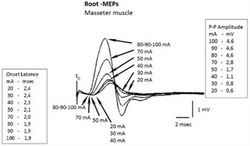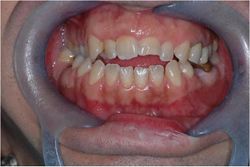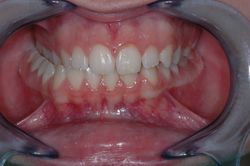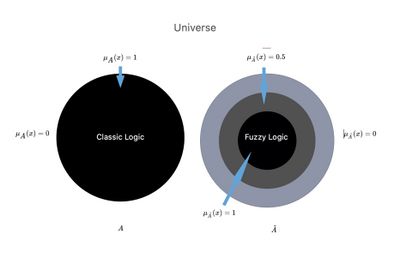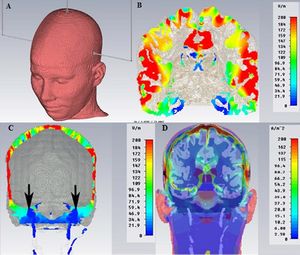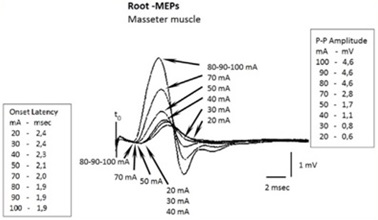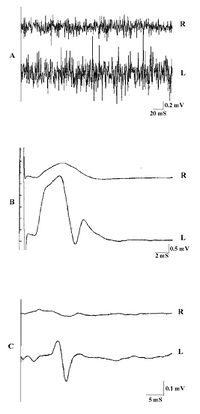| Other languages: |
Questo capitolo chiude il ciclo della "Logica del linguaggio medico" per introdurre un modello diagnostico nel campo delle funzioni masticatorie che combini la concettualità della logica di sistema con la meccanica quantistica. I modelli matematici statistici di una logica di sistema, quindi, non possono essere soggettivi, né approssimativi, tanto meno vaghi e non formali nell'ambito del modello clinico. Per ottenere queste caratteristiche è necessario considerare i concetti base della 'Teoria dei Sistemi'.
L'inconfutabile svolta diagnostica nella maggior parte delle discipline mediche risiede nella bioingegneria, nei progressi tecnologici e in particolare nella teoria dei sistemi. Consente di verificare lo stato di un sistema confrontando le variabili di output generate dalle variabili di input. Questo enorme passo avanti risiede nell'introduzione del concetto di trigger. La bioingegneria in ambito elettrofisiologico del trigemino ha consentito l'utilizzo di una serie di trigger (stimolazione elettrica transcranica, stimolazione magnetica transcranica, stimolazione meccanica del distretto trigemino) che ci consentono di testare il sistema con una risoluzione molto superiore a quella in cui il sistema viene testato senza rispondere a un trigger esterno. Un altro elemento chiave è che il modello trigger è in grado di fornire un'istantanea dello stato del sistema molti anni prima che si manifesti un evidente segno clinico patologico.
In questo capitolo spiegheremo alcuni passaggi di base da intraprendere per modellare metodi diagnostici seguendo la teoria dei sistemi.
Article by Gianni Frisardi · Giorgio Cruccu · Alice Bisirri · Pier Paolo Valentini · Flavio Frisardi · Irene Minciacchi
|
Prefazione
Perché siamo arrivati alla "Logica di sistema"? I passaggi non sono né banali, né personali, e per percepire il valore aggiunto della 'Logica di Sistema' non possiamo non citare due ragioni essenziali che hanno segnato questo percorso: quella degli indici clinici odontoiatrici e della logica del linguaggio medico.
Indici clinici odontoiatrici
Esistono 'Indici' che possono essere considerati elementi di System Logic come dati oggettivi, come l' 'equazione di Henderson-Hasselbalch' (per l'analisi del pH del sangue) e altri 'Indici' sviluppati in campo medico in discipline disparate.[1][2][3]
Un test, un dato di riferimento normativo o un 'Indice' sono strategie legate a modelli matematico-statistici che generano dati. Questi dati sono obbligatori per l'accuratezza della diagnosi, per la diagnosi differenziale e per le linee guida terapeutiche. Su questi dati di riferimento, ai tempi della storia scientifica dell'odontoiatria, si sono generate implementazioni e modifiche ma anche incertezze e convinzioni che sotto forma di assiomi o scuole di pensiero hanno tracciato linee guida non sempre scientificamente giustificabili, e talvolta false.
In literatura
Si possono prendere in considerazione i dati riportati in letteratura in merito agli 'Indici' studiati su pazienti affetti da 'Disturbi Temporomandibolari'[4] oppure entrare più nello specifico sulle riabilitazioni masticatorie e verificare l'argomento 'Indici Clinici' nelle discipline ortodontiche.[5]
In un recente articolo di Andrea Scribante e collaboratori,[6] ad esempio si deducono i seguenti paragrafi:
- L'introduzione afferma che la valutazione degli esiti del trattamento ortodontico è stata tradizionalmente effettuata utilizzando l'esperienza e le opinioni soggettive dei clinici.[7] In questo primo paragrafo si comprende il limite del concetto espresso e cioè un test diagnostico e/o una linea guida terapeutica non dovrebbe mai essere pesato scientificamente utilizzando parametri soggettivi.
- Tuttavia, dagli anni '90, sono stati sviluppati indici specifici per valutare oggettivamente gli esiti sulla salute analizzando la qualità del trattamento.[8] Questi indici confrontano i dati pre e post trattamento per determinare l'esito della terapia ortodontica[9] e per migliorare la qualità dei trattamenti futuri.[10] Questo secondo paragrafo scientificamente accettabile mette in evidenza lo scopo degli 'Indici' e cioè il pre e post-confronto - ma chi dice che il post a fine trattamento si trovi in stato di 'normocclusione' mentre nel pre si era in uno di 'malocclusione': l'allineamento dentale?
- L'indice più comunemente usato per valutare il successo ortodontico è il 'Peer Assessment Rating Index' (PAR), che è stato sviluppato per misurare fino a che punto un paziente si discosta dalla normale occlusione e allineamento dentale.[8] Questo indice è stato utilizzato per valutare gli effetti della terapia in diverse circostanze: l'uso di dispositivi fissi e mobili,[11] il confronto del trattamento ortodontico tra studi privati e scuole ortodontiche,[12] la valutazione della stabilità occlusale dopo il trattamento ortodontico,[13] i primi trattamenti[14] e i risultati della chirurgia ortognatica.[15] Bisogna considerare che PAR non indicherebbe il sano o il malato, normocclusione o malocclusione a seconda che si allontani dal cutoff ma a fronte di una serie di caratteristiche in ingresso restituirebbe una risposta ad ampio spettro (Indice), valida per trattamenti ortodontici e ortognatici. Questo stato d'animo è legittimo ma i clinici devono stare attenti perché le variabili di input (i "Costruttori") del modello o input, potrebbero non essere correlate al contesto di riferimento o potrebbero esserci altre variabili nascoste che invaliderebbero il risultato stesso . Apprezzeremo maggiormente queste affermazioni nell'esposizione dei capitoli di Masticationpedia.
Il fatto è che il primum movens dello studio di Andrea Scribante e collaboratori si concentra nel seguente punto:
(Limitativo....l'indice può avere una precisione e veridicità nell'allineamento dentale ma non per validare una normocclusione, quest'ultima affermazione è molto più complessa da formulare e certamente non può essere ridotta esclusivamente ad un 'osservabile occlusale'.)
Spyridon N. Papageorgiou[16] in uno studio molto interessante espone una coraggiosa affermazione che conferma quanto appena esposto:
- Nel post-debond si osservano notevoli alterazioni occlusali a lungo termine, che favoriscono principalmente un migliore assestamento. La finitura di qualità superiore al debond ha influenzato in modo significativo le possibilità di miglioramento. Tuttavia, l'impostazione di un punteggio limite per denotare l'eccellenza del trattamento ha mostrato una notevole instabilità nel tempo.
Altri autori affermano che la recidiva dopo il trattamento ortodontico può verificarsi anche nei casi con una buona occlusione funzionale.[17]
Ulteriori considerazioni
L'eziologia della recidiva non è né completamente compresa né completamente prevista da un singolo fattore,[18] ma include fattori come la risposta della trazione e delle fibre parodontali destrutturate,[19] la maturazione fisiologica della dentatura umana che ne influenza la larghezza, la lunghezza o il perimetro,[20] le alterazioni del complesso craniofacciale[21] e delle parafunzioni.[22]
La ritenzione dei risultati del trattamento è quindi considerata uno dei problemi più difficili in ortodonzia e si potrebbero osservare recidive, in particolare degli incisivi mandibolari, anche con l'uso di dispositivi di ritenzione dopo il debonding.[23] La maggior parte degli studi di stabilità post-trattamento esistenti valutano le recidive a breve termine della regione anteriore misurando principalmente l'irregolarità degli incisivi dopo il trattamento estrattivo o non estrattivo e confrontando diversi pattern di ritenzione. Questi studi utilizzano in gran parte l'indice del Peer Assessment Rating (PAR)[24], che non è un approccio di analisi elettrofisiologica del trigemino nel considerare la "Normocclusione", tanto meno i dettagli di un'occlusione ben bilanciata (come contatti, inclinazioni e allineamento di ciascun dente) o cambiamenti nella ritenzione solo a breve termine.[25]
A conoscenza degli autori al momento della pubblicazione del loro studio, solo uno studio[26] ha utilizzato il sistema di classificazione oggettiva dettagliata dell'American Board of Orthodontics (ABO)[27] per modelli e radiografie che misura i dettagli di un'occlusione ben rifinita e ben bilanciata.
(Constructive criticism, however, is inherent in the statement itself: how is an efficient masticatory function and, therefore, a 'Normocclusion' defined?)
In Masticationpedia, we would like to launch interesting and constructive provocations to answer the question we just set out: 'How is an efficient chewing function and therefore a Normocclusion defined?'
Let's look at the two cases below, in figure 1 and in figure 2: which of the two clinical cases do you think is affected by malocclusion?
It seems irreverent for the canons of orthodox orthodoxy not to share the diagnosis of 'malocclusion', but we leave the reader in a little suspense. We intend to resume extensively in a few chapters, after deepening the topic of 'System Logic' and 'Systems Theory'. We only anticipate that the patient in figure 1 has already been proposed in the chapter 'Introduction', so we already know our clinical scientific opinion but if he gives us so much, also.....
(... be patient and you will see)
Medical language logic
In the previous chapters we highlighted the extreme difficulties we met in defining an exact, detailed and timely diagnosis in the right time; and this is not only due to the 'Complexity' of the living system, but also to a questionable and vague logic of medical language. If classical logic is too selective (true or false, and therefore 'there is no third answer' - principle of the excluded third), it is also true that probabilistic logic language, which trivially indicates the presence of a specific disease, breaks down in the 'significativity' parameter that acquires a certain value only in a 'specialist context'.
We perceived the need for a more elastic model called "fuzzy logic" that could translate the uncertainty inherent in some human language data into mathematical formalism, codifying the "elastic" concepts (such as almost high, fairly good, etc), in order to make them understandable and manageable by computers.
We have therefore frozen a much debated and approached concept in the chapter 'Introduction': not determining a clear separation between specialist know-how, but superimposing interdisciplinary knowledge, instead, through a 'Fuzzy' approach (see fuzzy logic language).
Systems Theory
In the scientific field, systems theory, more properly general system theory (definition by Ludwig von Bertalanffy),[28] is an often interdisciplinary field of study, straddling mathematics and natural sciences, which deals with the analysis of properties and the constitution of a system. It is essentially composed of the theory of dynamic systems (simple and complex) and of the theory of control: it is the basis of various disciplines such as automation, robotics and cybernetic physics, as well as the technical-scientific study of systems in general as much as in biology and medicine.
Systems theory is the interdisciplinary study of systems, that could be described as cohesive groups of interconnected and interdependent parts that can be natural or man-made. Each system is bounded by space and time, influenced by its environment, defined by its structure and expressed through its functioning. A system can be more than the sum of its parts if it expresses emerging synergies or behaviors.[29]
Changing one part of a system might affect other parts or the whole system. It may be possible to predict these changes in behavior patterns. Some systems support other systems, keeping the others to prevent failure. The goals of systems theory are to model the dynamics, constraints, conditions of a system and to clarify the principles (such as purpose, measure, methods, tools) that can be identified and applied to other systems at any level of nesting and in a 'wide range of fields to achieve optimized equifinality.[30]
To be practical and effective in the description of the concept 'System logic' we consider an approach to a part of the trigeminal motor system, since it is the cornerstone of this scientific work, in which the conceptual connection with the 'Theory of Systems'.
Masticatory System Logic
Regarding the analysis of the state of the masticatory system, the EMG technique has been widely used but there are still a number of concerns regarding the reliability of the measures based on the interferential EMG. [31]
This is why most of the studies performed so far aimed at showing a possible correlation between EMG signals with Temporomandibular Disorders (TMD), Orofacial Pain (OP) or Malocclusion (IO), but they have not yielded convincing results.[32]
In an unknown percentage of OP patients visited by specialist dentists, some neurological diseases such as intracranial tumours, multiple sclerosis, etc. are the underlying symptoms cause of TMD or OP.
These patients, who actually suffer from neurological symptoms superimposed on dental-facial ones, may undergo unnecessary dental interventions before the correct diagnosis is made, sometimes too late.[33]
(... as said, the 'Observable' cannot be the occlusal element because it is hierarchically lower than the Trigeminal Nervous System.)
Cortical projections to the trigeminal motor neurons are generally believed to be bilateral and symmetrical and can be electrophysiologically analyzed by electrical or magnetic brain stimulation through the intact scalp.[34]
In the ipsilateral masseter, the transcranial electrical stimulation (eTCS) is capable of evoking a large short-latency potential in relaxed and active muscles. The characteristics of ipsilateral Motor Evoked Potentials (MEPs) do not change under relaxed or active conditions. Mean onset latency is approximately 2 ms, peak latency of 3.9 ms and amplitude of 5.4 mV, and there is no latency variability in similar pacing conditions. These motor potentials, considered secondary to trigeminal motor root excitation, have been called Root-MEP (Root-MEP or simplified into R-MEPs) to differentiate them from M-waves and Cortex-MEPs.[35]
To make the understanding of 'Systems Theory' more suitable for the context of the masticatory system, we report some trigeminal electrophysiological procedures and implement them with the mathematical models of the theory.
Mathematical formalism in 'Systems Theory'
The "systems theory" studies oriented systems, in which it becomes possible to classify the quantities of interest into two categories:
- quantities that vary over time independently from the others (inputs)
- quantities whose evolution over time is to be studied, depending on the inputs, called outputs.
A real system can have multiple inputs and multiple outputs. In particular, we indicate with:
- the vector of the inputs at time
- the vector of the output at time
It is also generally defined as the state vector of the system in a generic instant the information instantly necessary to uniquely determine the output for each once the entrance has been assigned .
We denote the state vector, whose components are defined as state variables, with the notation .
The inputs act on the state of the system and modify its characteristics at a given moment in time; these changes are recorded by the state variables. The values of the system outputs, usually the only measurable variables, in turn depend on the system state variables and the inputs.
The input, status and output quantities are functions of the time variable.
This takes values in an ordered subset , which can be continuous or discrete. In the following discussion we will consider a discrete subset of times:
Therefore, given a set of times , we can formally define a system as the pair of equations
with , where is called generating function e is called the output transformation.
In the field of biosignals, the () models are used to analyze EEG and vibration systems in vehicles, human hearing systems and vascular systems, and so on. While much is still unknown about the physiological mechanism or pattern of internal changes in the tested system, the output transfer or transformation function in our context allows us to reconstruct a wave function by interpolating the points detected by the instrument which has its own particular sampling frequency. This function, for our purposes, is a reconstruction of a wave function on which to search for latencies, amplitudes and integral areas and make the necessary conclusions,[36][37] and, obviously, by retesting the system in subsequent epochs, the integrity of the system itself can be compared.
In the engineering field, various mathematical modeling of a system are possible, depending on whether or not they explicitly consider the state variables.
Mathematical formalism of the Trigeminal System Logic
We consider the Trigeminal Motor System as a black box with inputs (figure 5) and outputs (figure 6), and we try to adapt to it the above described theory.
Figure 6 shows the neuromotor responses to the electrical transcranial stimulation of the trigeminal root of the right hemilate. We wanted to set up the test following the mathematical model of 'systems theory' to better understand the difference between the information obtained from a now almost inflated test such as the interferential EMG, and a more complex test such as a motor and/or somatosensory evoked potential; the evoked potential has the prerogative of a system response to an external input called 'trigger', which in this context is of an electrical type.
We divided the test by delivering a series of progressively greater electrical stimuli in the ordered times corresponding to.
In our context, we will have one input, i.e. the electrical stimulation amperage and two outputs, i.e. latency and amplitude.
We will therefore have:
mA.
Two state variables will correspond to each of these inputs: latency and amplitude .
ms
mV
All these variables generate a plotting of multiple mediated traces as in figure 6, in which some important considerations can be made, such as the decrease in latency and the increase in amplitude as the amperage increases.
Conclusion
It is plausible that the reader, or a colleague not accustomed to particular trigeminal electrophysiological procedures, may consider this type of bioengineering diagnostic models exaggerated, both for the difficulty in the execution (that can make the methodology seem dangerous - the Root-MEPs delivers an electric current of 100 V with an amperage of 100mA), and for the feeling he might have that the cost benefit is unjustified; so, he might prefer to continue with the now routine methodology in dentistry, such as performing a simple, fast and inexpensive interferential EMG (Figure 7A). We certainly accept the opinion of our hypothetical colleague, but we do not share it because, to save a human life, competence is always and critically required, together with dedication and both intellectual and economic investment.
The irrefutable step forward made in diagnostics in most medical disciplines, as already mentioned, lies precisely in bioengineering, technological progress; specifically, systems theory has allowed us to verify the system state by comparing output variables generated by variables incoming payments which are basically triggers of various types.
Figure 7 is a way of demonstrating this. Notably, like the interferential EMG test shows (Figure 7A), only a sort of interferential asymmetry typical of clinical situations of malocclusion can be observed, while through a trigger model (specifically, the bilateral transcranial electrical stimulation of the trigeminal roots) the system responds with a large amplitude asymmetry (Figure 7B) and even with an absence of the jaw jerk response (evoked with a mechanical trigger by striking the chin with a neurological piezoelectric hammer). (Figure 7C) The diagnostic conclusion of this patient was of skull base menygoma.
For the experts, of course, a glance is enough to understand whether the trigeminal motor system evoked through electrical transcranial stimulation of the motor roots is in a physiological or pathological state; but, as we will see in the next chapters, the biological reality is so complex and paradoxically indeterministic, that a bioengineering model paired with an adequate statistical mathematician will allow us to approach more accurately the real physiopathological state of the system, reduce the uncertainty of the measurement and consequently the differential diagnostic error but above all make early diagnosis.
In any case, if this patient had undergone the described diagnostic model, he would not have died, because the growth of the tumor mass of a meningioma is extraencephalic, and slow, and would have shown an electrophysiologically documentable destructuring many years before the vertiginous symptomatology.
- ↑ Wei Xiao, Yi Yang, Jiao Shi, Jia Xu, Jianguang Zhu, Zhinong Wu, «The diagnostic efficacy and predictive value of combined lipoprotein laboratory indexes for atherosclerosis», in J Pak Med Assoc, 2020».
PMID:33177739 - ↑ Diana Ferraro, Roberta Bedin, Patrizia Natali, Diego Franciotta, Krzysztof Smolik, Mario Santangelo, Paolo Immovilli, Valentina Camera, Francesca Vitetta, Matteo Gastaldi, Tommaso Trenti, Stefano Meletti, Patrizia Sola, «Kappa Index versus CSF Oligoclonal Bands in Predicting Multiple Sclerosis and Infectious/Inflammatory CNS Disorders», in Diagnostics (Basel), MDPI, 2020».
PMID:33096861 - PMCID:PMC7589948
DOI:10.3390/diagnostics10100856
This is an Open Access resource! - ↑ Huseyin Kayadibi, Baris Yilmaz, Abdullah Ozgur Yeniova, Huseyin Koseoglu, Zahide Simsek, «Development and evaluation of a novel noninvasive index for predicting significant fibrosis, advanced fibrosis, and cirrhosis in patients with chronic hepatitis B infection», in Eur J Gastroenterol Hepatol., 2021».
PMID:33177385
DOI:10.1097/MEG.0000000000001973 - ↑ Results in PubMed for "Temporomandibular disorders Index"
- ↑ Results in PubMed for "Orthodontics Indexes"
- ↑ Maria Francesca Sfondrini, Paolo Zampetti, Giulia Luscher, Paola Gandini, José Luís Gandía-Franco, Andrea Scribante, «Orthodontic Treatment and Healthcare Goals: Evaluation of Multibrackets Treatment Results Using PAR Index (Peer Assessment Rating)», in Healthcare (Basel), MDPI, 2020».
PMID:33182796 - PMCID:PMC7711869
DOI:10.3390/healthcare8040473.
This is an Open Access resource! - ↑ Dyken RA, Sadowsky PL, Hurst D, «Orthodontic outcomes assessment using the peer assessment rating index», in Angle Orthod, The EH Angle Education and Research Foundation, Inc., 2001».
PMID:11407767
DOI:<0164:OOAUTP>2.0.CO;2 10.1043/0003-3219(2001)071<0164:OOAUTP>2.0.CO;2 - ↑ 8.0 8.1 Richmond S, Shaw WC, O’Brien KD, Buchanan IB, Jones R, Stephens CD, Roberts CT, Andrews M, «The development of the PAR Index (Peer Assessment Rating): reliability and validity», in Eur J Orthod, Oxford University Press, 1992, Oxford UK».
PMID:1582457
DOI:10.1093/ejo/14.2.125 - ↑ Onyeaso CO, BeGole EA, «Associations between pretreatment age and treatment time with orthodontic treatment outcome: A comparison by means of two orthodontic indices», in Hell Orthod. Rev, MDPI, 2008, Basel, Switzerland».
- see alsoThis is an Open Access resource! - ↑ Hickman JH, «Directional edgewise orthodontic approach. 5», in J Clin Orthod, 1975».
PMID:1054697 - ↑ Firestone AR, Häsler RU, Ingervall B, «Treatment results in dental school orthodontic patients in 1983 and 1993», in Angle Orthod, The Edward H. Angle Society of Orthodontists, Inc., 1997, Bern, Switzerland».
PMID:10022180
DOI:<0019:TRIDSO>2.3.CO;2 10.1043/0003-3219(1999)069<0019:TRIDSO>2.3.CO;2 - ↑ Cook DR, Harris EF, Vaden JL, «Comparison of university and private-practice orthodontic treatment outcomes with the American Board of Orthodontics objective grading system», in Am J Orthod Dentofacial Orthop».
PMID:15953896
DOI:10.1016/j.ajodo.2004.12.014 - ↑ Ramanathan C, «PAR index in the evaluation of the stability of the orthodontic treatment results. A review», in Acta Medica (Hradec Kralove), 2006, Hradec Králové, Czech Republic».
PMID:17438831
DOI:10.14712/18059694.2017.133 - ↑ Pangrazio-Kulbersh V, Kaczynski R, Shunock M, «Early treatment outcome assessed by the Peer Assessment Rating index», in Am J Orthod Dentofacial Orthop, 1999».
PMID:10229887
DOI:10.1016/s0889-5406(99)70277-5 - ↑ Templeton KM, Powell R, Moore MB, Williams AC, Sandy R, «Are the Peer Assessment Rating Index and the Index of Treatment Complexity, Outcome, and Need suitable measures for orthognathic outcomes?», in Eur J Orthod, Oxford University Press on behalf of the European Orthodontics Society, 2006, Oxford UK».
PMID:16648208
DOI:10.1093/ejo/cji120 - ↑ Spyridon N. Papageorgiou, Theodore Eliades, Christine Angst, «Stability of occlusal outcome during long-term retention: the time-dependent variation of the American Board of Orthodontics index», in Eur J Orthod, Zurich Open Repository and Archive, University of Zurich, 2021, Zurich, Switzerland».
PMID:32144422
DOI:10.1093/ejo/cjaa004 - ↑ Nadia Lyotard, Mark Hans, Suchitra Nelson, Manish Valiathan, «Short-term postorthodontic changes in the absence of retention», in Angle Orthod, 2010».
PMID:20677953 - PMCID:PMC8929484
DOI:10.2319/010210-7.1 - ↑ Little RM, «Stability and relapse of dental arch alignment», in Br J Orthod., University of Washington, Seattle, 1990, Washington, USA».
PMID:2207055
DOI:10.1179/bjo.17.3.235 - ↑ Reitan K, Kvam E, «Comparative behavior of human and animal tissue during experimental tooth movement», in Angle Orthod, 1971».
PMID:4992550
DOI:<0001:CBOHAA>2.0.CO;2 10.1043/0003-3219(1971)041<0001:CBOHAA>2.0.CO;2 - ↑ Birgit Thilander, «Dentoalveolar development in subjects with normal occlusion. A longitudinal study between the ages of 5 and 31 years», in Eur J Orthod, Oxford University Press on behalf of the European Orthodontic Society, 2009, Göteborg, Sweden».
PMID:19304760
DOI:10.1093/ejo/cjn124 - ↑ Behrents RG, Harris EF, Vaden JL, Williams RA, Kemp DH, «Relapse of orthodontic treatment results: growth as an etiologic factor», in J Charles H. Tweed Int Found, 1989».
PMID:2634695 - ↑ Günter Lang, Günter Alfter, Gernot Göz, Günter H Lang, «Retention and stability--taking various treatment parameters into account», in J Orofac Orthop, 2002».
PMID:11974450
DOI:10.1007/s00056-002-0036-2 - ↑ Jeanett Steinnes, Gunn Johnsen, Heidi Kerosuo, «Stability of orthodontic treatment outcome in relation to retention status: An 8-year follow-up», in Am J Orthod Dentofacial Orthop, 2017».
PMID:28554448
DOI:10.1016/j.ajodo.2016.10.032 - ↑ Karina Maria Salvatore de Freitas, Guilherme Janson, Marcos Roberto de Freitas, Arnaldo Pinzan, José Fernando Castanha Henriques, Célia Regina Maio Pinzan-Vercelino, «Influence of the quality of the finished occlusion on postretention occlusal relapse», in Am J Orthod Dentofacial Orthop, 2007».
PMID:17920494
DOI:10.1016/j.ajodo.2007.02.051 de Freitas, K.M., Janson, G., de Freitas, M.R., et al. Influence of the quality of the finished occlusion on postretention occlusal relapse. American Journal of Orthodontics and Dentofacial Orthopedics, 132, 428.e9-14. - ↑ Hoybjerg, A.J., Currier, G.F., Kadioglu, O. Evaluation of 3 retention protocols using the American Board of Orthodontics cast and radiograph evaluation. American Journal of Orthodontics and Dentofacial Orthopedics, 2013, 144, 16-22.
- ↑ Nett, B.C., Huang, G.J.Long-term posttreatment changes measured by the American Board of Orthodontics objective grading system. American Journal of Orthodontics and Dentofacial Orthopedics, 2005, 127, 444-50.
- ↑ Casko, J.S., Vaden, J.L., Kokich, V.G., Damone, J., James, R.D., Cangialosi, T.J., Riolo, M.L., Owens, S.E. Jr and Bills, E.D. Objective grading system for dental casts and panoramic radiographs. American Board of Orthodontics. American Journal of Orthodontics and Dentofacial Orthopedics, 1998, 114, 589–599.
- ↑ Ludwig von Bertalanffy, «General System Theory: Foundations, Development, Applications», George Braziller, 1968, New York».
ISBN: 978-0807604533 - ↑ Emergent Behaviour
- ↑ Equifinality
- ↑ Reaz MB, Hussain MS, Mohd-Yasin F (2006) Techniques of EMG signal analysis: detection, processing, classification and applications (Correction). Biol Proced Online 8: 163.
- ↑ Masci C, Ciarrocchi I, Spadaro A, Necozione S, Marci MC, et al. (2013) Does orthodontic treatment provide a real functional improvement? A case control study. BMC Oral Health 13: 57.
- ↑ Moazzam AA, Habibian M (2012) Patients appearing to dental professionals with orofacial pain arising from intracranial tumors: a literature review. Oral Surg Oral Med Oral Pathol Oral Radiol 114: 749-755.
- ↑ Merton PA, Morton HB (1980) Stimulation of the cerebral cortex in the intact human subject. Nature 285: 227.
- ↑ Cruccu G, Berardelli A, Inghilleri M, Manfredi M (1989) Functional organization of the trigeminal motor system in man. A neurophysiological study. Brain 112: 1333-1350.
- ↑ Haebeom Lee, Hyunho Kim, Jungkuk Kim, Hwan-Sup Oh, Young-Jae Park and Young-Bae Park. Feasibility study of transfer function model on electrocardiogram change caused by acupuncture. BMC Complement Altern Med. 2017; 17: 101. Published online 2017 Feb 8. doi: 10.1186/s12906-017-1615-5
- ↑ Golnoosh Kamali, Rachel June Smith, Mark Hays, Christopher Coogan, Nathan E. Crone, Joon Y. Kang, and Sridevi V. Sarma. Transfer Function Models for the Localization of Seizure Onset Zone From Cortico-Cortical Evoked Potentials. Front Neurol. 2020; 11: 579961. Published online 2020 Dec 10. doi: 10.3389/fneur.2020.579961
particularly focusing on the field of the neurophysiology of the masticatory system
